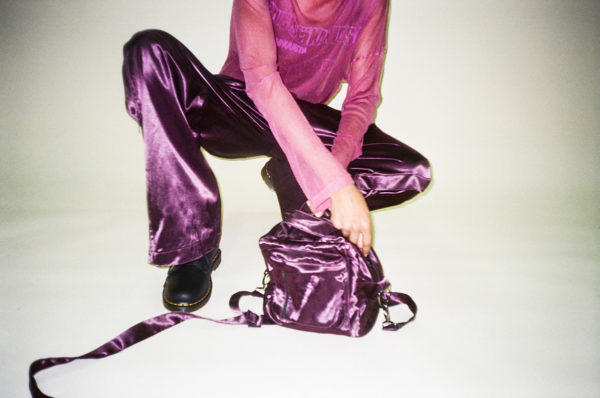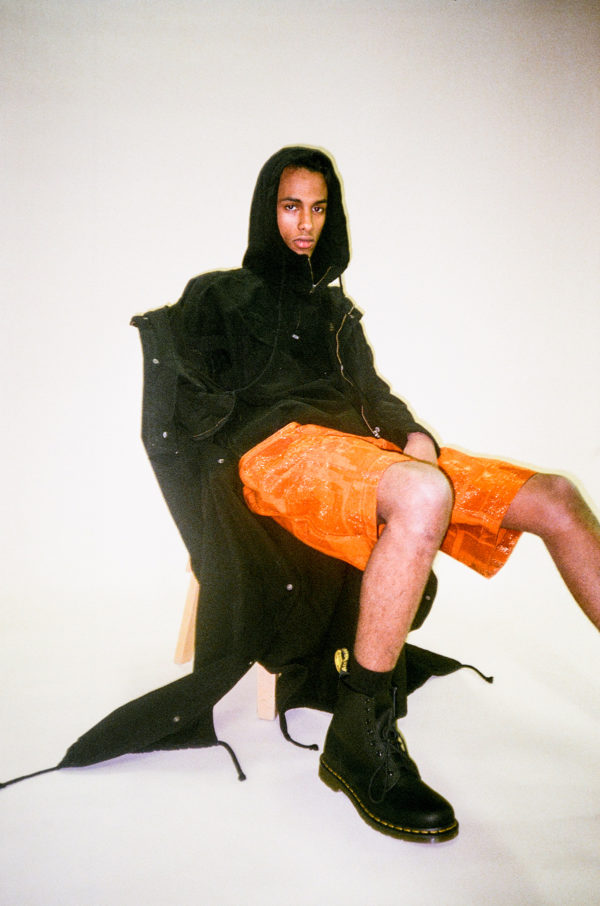Every month, Institut finlandais highlights creatives whose work sheds light on today’s Finland and France. In February, we met Maria Korkeila, a designer who has been awarded at the Hyères Festival and who has worked for Rick Owens’ textile team as well as YSL’s womenswear team.
Re-invented DIY and punk aesthetics could be words to define your design. Can you tell us about your creative process, how do your ideas translate into something wearable?
The nature of my working process tends to be very organic. I work very hands-on and I get a lot of ideas through trial and error, which translates to the DIY aesthetic you mentioned. I prefer not to over-process things, aesthetically: it should look and feel effortless.
You are currently based between Paris and Helsinki. What would you consider as the main difference between the two, especially in regards to the impact these cities are having on your creative practice? What are your favourite spots in Paris?
Paris is indisputably the capital of fashion, whereas Finland still lies on the periphery of the industry. In recent years young Finnish designers, mainly from Aalto University, have been making a mark internationally, winning prizes and working in fashion houses in all the main fashion cities. At times we are compared to Belgium, a previously which saw the rise of a group of cult designers in the 1980-90s, and we are often asked why Finland, why now…
Aesthetically speaking, in Finland, fashion (with a capital ‘F’) doesn’t have a very visible presence on the streets, in terms of dressing, or advertising and so on. This, I believe, often means that visual stimuli comes from somewhere else which in turn translates to different kinds of collections, meaning Finnish designers literally have a different perspective on fashion. The lack of major fashion houses in Finland liberates us from expectations, we get to create “Finnish fashion”, which I think can be seen as a positive. At the same time this means that job opportunities are also few and far between, unless you start your own label. Finland has a long way to go in developing the industry and infrastructure to support a larger and self-sustaining fashion industry.
In Paris I have more job opportunities, but in terms of my own creative practice, access to as wide a variety of textile studios as I have in Finland is hard to find, which inevitably changes the way I approach my design work. I wouldn’t say this it is better or worse, just different.
My favorite thing to do in Paris is just to wander around the streets people-watching. I often do this ranging from northern parts of the city (9th & 18th arrondissements) to Belleville and beyond. I love to visit museums and exhibitions (Palais de Tokyo and The Community for example). In the summer I like to hang out at Buttes-Chaumont.

Learning new skills has never been easier and automation will eventually render technical skills obsolete: thinking and feeling is more important.
Photography, music, arts – you work as a fashion designer, but your approach can definitely be characterised as interdisciplinary. How do you feel about the need to categorise different creative disciplines, especially regarding the conversation of fine arts versus industry-based practices?
Designing collections is about so much more than mere product development. The work should transcend clothes into something bigger: a concept, a feeling, an idea… The garments are separate encapsulations of this. Images and presentations put together the pieces of the puzzle into a coherent narrative. I think (good) fashion design is a combination of image-making (image as an aesthetic) and product-development, making photography more a tool than a separate discipline, for me.
My relationship with music is more complex: it simultaneously plays an important role in my design work in terms of inspiration, yet I see making music as this separate thing, coming from a different place. If I have to categorise I would prefer to say music is more of a hobby, and I would like to keep it this way, in the sense that I prefer to keep it less as an obligation and more as something made for pure enjoyment.
Generally speaking I think one way to look at it is that regardless of specified discipline, creativity comes from a more abstract place which can be channelled into different forms and formats depending on the medium and its purpose. Learning new skills has never been easier and automation will eventually render technical skills obsolete: thinking and feeling is more important. On the other hand I’m personally a total geek who loves to know how everything is done, I get a lot of ideas through the process of making (and as aforementioned: trying and failing). Also, from a fashion designer’s perspective knowing how garments are constructed is essential to designing. Also, regardless of the field I think it’s important to be familiar with its history, in order to know where you fall in the scheme of things, and who/what you are referencing, regardless of whether we are talking about fine arts or industry-based practices. And, unless you are an absolute genius I think it’s a bit tricky to keep track of all industries (past and present). That said, perhaps the best way to approach interdisciplinary work would be through collaboration.
In recent years, Aalto University has confirmed its place at the forefront of the international fashion world. What’s the secret to the success?
The course, spearheaded by Tuomas Laitinen, offers a curriculum that resembles those taught at top-notch universities like Central Saint Martins. The BA program was recently listed third on BOF’s renowned global fashion school ranking, and for good reason. The classes are small, meaning it is not an easy feat to be accepted, but also that students get a lot of one-on-one tutoring and personal assistance in their work. The facilities at the school are amazing and for students from Finland and the EU, the course is tuition-free. Also, what I like is that there is a very supportive atmosphere both amongst students and with teachers and staff. It’s a highly competitive field and yet there seems to be this general mentality of encouraging and cheering on fellow students, rather than being jealous over other people’s success. We are encouraged to participate in competitions and get a lot of help in finding jobs and internships even after graduation, which is amazing.
From Hyères festival to Pitti Uomo, recently you’ve worked on several major fashion events and interesting collaborations. What’s next for you?
At the moment I am freelancing and starting another collection of my own. I think it would be interesting to continue collaborating with different people and brands, as I hope to continue working with a wide range of projects as I have been doing so far, but I’m definitely not ruling out going for an in-house job either (if anyone at Raf Simons is reading this hit me up!).
Portrait of Maria: Sofia Okkonen
Fashion photography: Maria Korkeila



